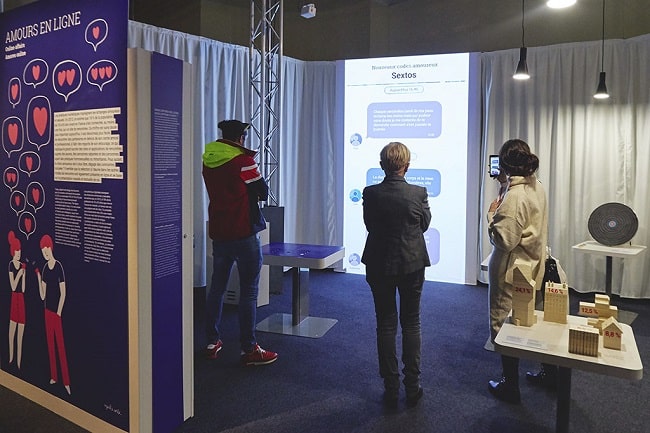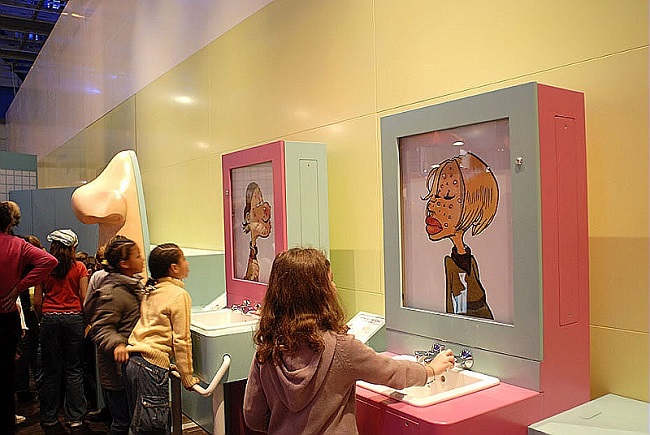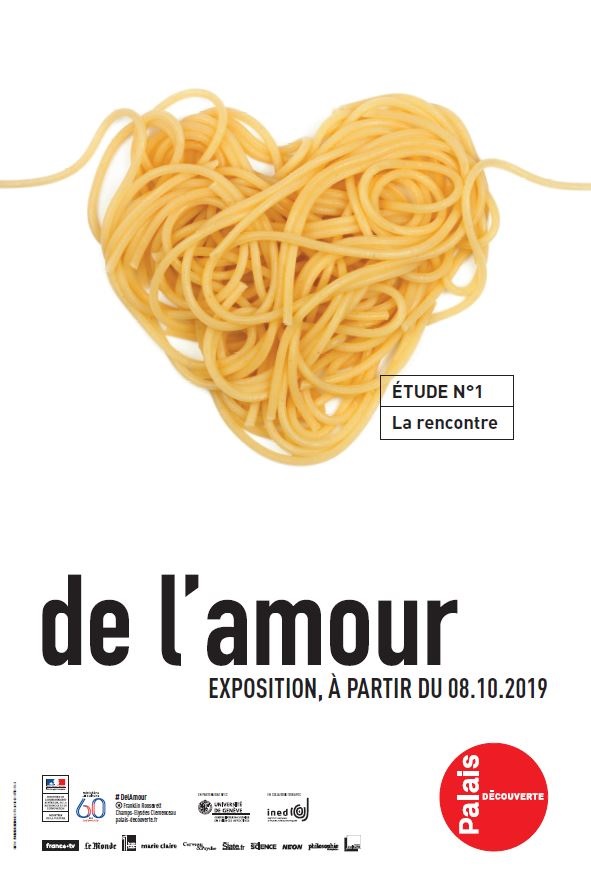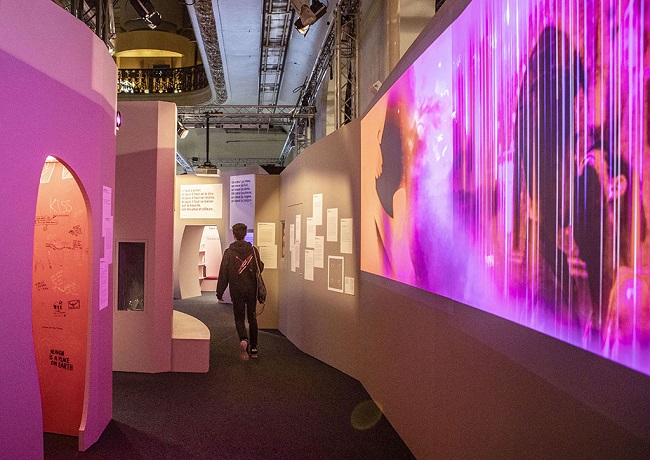De l’Amour at the Palais de la Découverte: Love Viewed through a Cultural Lens
- SUBSCRIBE
- ALREADY SUBSCRIBED?
BECOME A BONJOUR PARIS MEMBER
Gain full access to our collection of over 5,000 articles and bring the City of Light into your life. Just 60 USD per year.
Find out why you should become a member here.
Sign in
Fill in your credentials below.
A stack of stuffed animals welcomes visitors to a blockbuster exhibit at Palais de la Découverte, the science museum in the center of Paris, originally part of the Grand Palais.
In 1937 the elaborate structure– built in the surge of construction that also included the Eiffel Tower, the Grand Palais, Pont Alexandre III and the Petit Palais— was designated as an exhibition space for “Art and Techniques in Modern Life”, an international collaboration. It was then converted to serve the nation as a center for science display, exploration and education. In 1986, the enormous Cité des Sciences et de l’Industrie was built on the edge of Parc de la Villette to offer a broader range of permanent and temporary exhibits, a larger planetarium, a 360-degree theater, and more open spaces for programming. The Palais de la Découverte continued to thrive and 10 years ago the two science museums officially merged.
With its central and easily accessible location, the Palais de la Découverte has remained a destination for curious visitors of all ages as well as for researchers. In the past 20 years, in addition to more permanent installations, we have enjoyed exhibitions ranging from the social lives of ants to the anatomy of hair to the experience of heat and cold. During more than 100 years, however, the infrastructure of the beautiful building has been aging.
On August 30, 2020, the Palais de la Découverte will close for four years, moving some of its resources temporarily to a 770 square meter construction by the garden Caroline-Aigle in Parc André Citroën. In 2024 the renovations will reveal increased accessibility, improved security, and expanded modern programming that can accommodate 21st century technology, enhancing pursuit of the museum’s mission of welcoming students, researchers, and visitors who are interested in scientific inquiries that illuminate the historical, the current day, and future possibility.

Copyright: R Thenadey-EPPDCSI
Currently, two temporary exhibitions, one on love (“de l’amour”) and the other on magnetism, are gifts to the public before this cultural gem begins its transformation.
“de l’amour” explores the topic of love from two perspectives – that of experience, as captured through the humanities – in philosophy, poetry, film, sounds, and art, and that of research, viewed through science – biology, sociology, anthropology, psychology, psychiatry, chemistry, and neuroscience. The humanities section comes first, a decision which felt to me, as a research psychologist, just right. After all, the first task of science is to describe a phenomenon. What better way than to explore the meanings of “love” across the range of human expression? And metaphor has always expanded meaning. Collections of poems and prose, written in French, English and Spanish, are sprinkled throughout displays on the kinds of love defined by ancient Greek philosophers: eros, or passion; agape, or selfless love (as in altruism); storge, love for family; and philia, abiding friendship. Attachment, empathy, yearning and sharing can characterize them all.
At the entrance to the exhibit, a tower of stuffed animals, eternally embraced by children of all ages in Western cultures, greets the visitor. They symbolize the centrality of attachment, first to a caregiver and then to what D. W. Winnicott, the famous British developmental psychiatrist, labeled a “transitional object”. Soft playthings are often our first emotional attachments outside of our caregivers. To the credit of the designers of the exhibit, ambivalence speaks subtly through playthings that have been the target of violence as well as affection. Nor have they ignored the conflicts of parenthood: mixed feelings are expressed in many writings and in a sound booth filled with written and spoken words that capture the full range of human emotion. As a research psychologist, whose investigations focused on love relationships, I believe that the more two people can permit depth and nuance in experience, the more honest and enduring their bonds can be.

Copyright: Palais de la Découverte
Following “Attachment”, the first section of the exhibit winds through observations of and commentaries on physical passion, complete with a label at the entrance to a video that is clearly inappropriate for certain sensibilities, even, or especially, for children living in a culture that openly embraces sexuality.
More writings, displays, illustrations and interactive opportunities appear and then the story continues as the visitor steps into the second part of the exhibition, the world of scientific studies of love. An introductory film, “Parlez-moi d’amour” (Speak to me of love) features eight experts describing their research programs on topics as diverse as the “real” reason Japanese men are buying lifesize sex dolls to the importance of “exchange”, whether of material goods, information, acts or other means in the management of a love relationship, and the biochemistry of love. Researchers in anthropology, sociology, philosophy, psychiatry, and chemistry offer descriptions of their work accompanied by charming animations. Subtitles appear in English or Spanish translations beneath the original French text in two alternating versions of the engaging 25-minute large-format film.
One thesis of the exhibition stresses how digital technology has transformed the ways in which people are now forming and maintaining personal connections. The impact of electronics is especially strong on those in younger generations and for people who hold less traditional sexual preferences. Three-dimensional models show where and how people are now meeting their eventual sexual partners and the trajectories the relationships take after initial connections are made. Nearby, a texted conversations appear on a giant screen, as flirting takes place in virtual reality. In an adjacent area, an interactive game allows two people to imagine what they might exchange with one another depending on the goals of the relationship – from a casual “one-night stand” to a lifelong commitment. An underlying model of economics seems to drive this view of love relationships, as they are seen more as a matter of exchange or “doing business”, rather than of a commitment, in which the welfare of the whole is of primary concern.
The scientific part of the presentation does a particularly good job in explaining what we have learned from research about attachment, as it begins in infancy, affects emotional regulation, and finally and profoundly influences adult love relationships. Descriptions of the four attachment styles that are now most commonly differentiated (secure, avoidant, anxious/ambivalent-fearful, disorganized) and how they manifest in adult love relationships is especially well done and is consistent with the last decades of research on attachment, approached from several different perspectives.

Copyright: R Thenadey-EPPDCSI
This exhibit is ambitious, expansive, and insistent upon multiple approaches to exploring and understanding love. I was particularly struck again (as in the hugely successful exhibit “le Zizi” for preteens at Cité des Sciences in 2007 and repeated there in 2014) by the French comfort with the needs of and messages from the human body, including those regarding sexuality. In “de l’amour”, sex and intimacy are explored in videos, words, lectures, games. One display defines ways in which the body responds in love situations; another addresses how the brain is sending out the commands for such responses. Sexuality is embraced as a natural and variable part of relationships, and relationships are understood as essential to human well-being.
The “de l’amour” exhibition is a fine gift to visitors as the Palais de la Découverte prepares for its own transformation into a future that will require flexibility in approaches to understanding, collaboration in communicating what we know and hope to learn, and asking questions that will demand responses as we bring our ancient capacities of love and curiosity into tomorrow’s world. A book available in the gift shop as a souvenir of the exposition, De l’Amour, Fragments d’un Discours Scientifique, has sections written by a philosopher, a child psychiatrist, a sexologist, a sociologist, and a psychiatrist-anthropologist, along with beautiful illustrations and graphs; it expands the information and topics of exploration even further. Unfortunately, at this time the book is available only in French, but isn’t French “the language of love”?!
Palais de la Découverte
Next to the Grand Palais
Avenue Franklin Delano Roosevelt, 8th
Full-price ticket is 9 euros
Closed Mondays
Love Paris as much as we do? Get some more Paris inspiration by following our Instagram page.

Copyright: Palais de la Découverte
Lead photo credit : Image credit: N Breton-EPPDCSI-87





REPLY